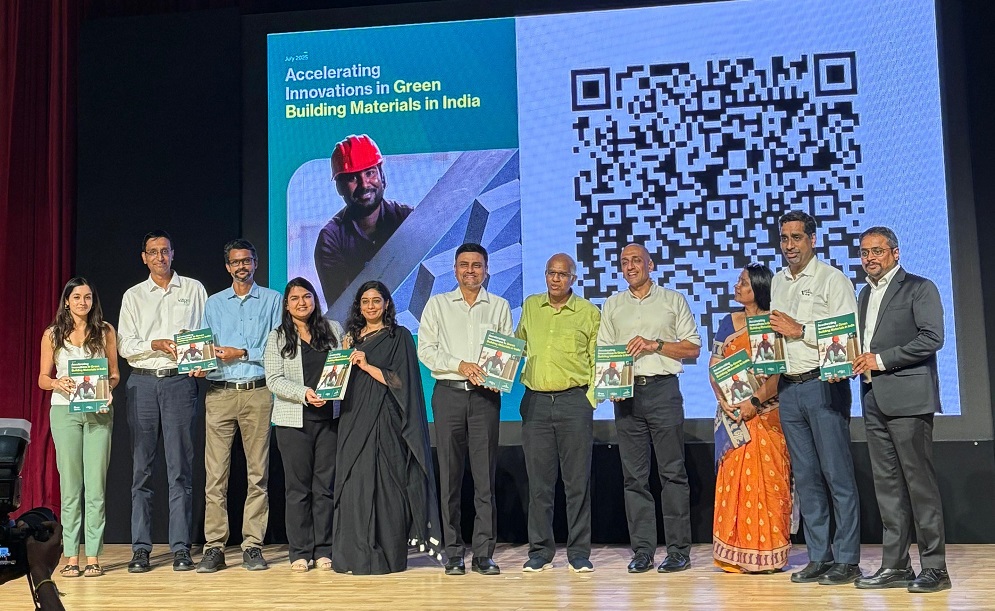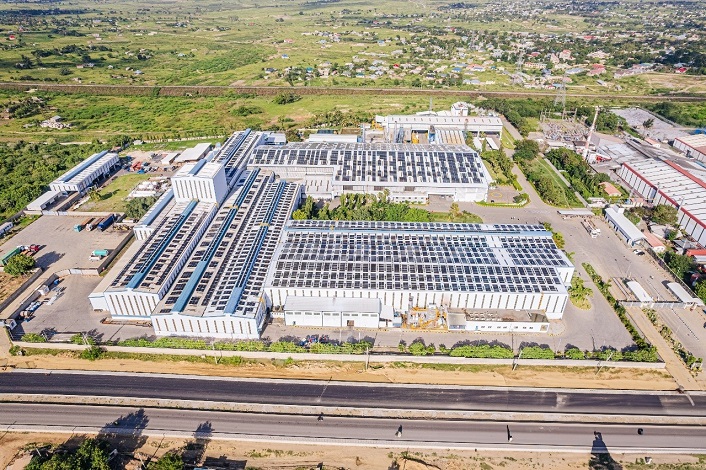As India stands on the brink of an unprecedented construction boom – set to double the nation’s current built-up area by 2050– green building materials (GBMs) are emerging as a compelling alternative to conventional, high emissions materials such as cement and steel, creating an opportunity to decarbonize the construction sector. In a bid to catalyse broader adoption of GBMs, Villgro Innovations Foundation and Habitat for Humanity’s Terwilliger Center for Innovation in Shelter, with the support of Saint-Gobain and knowledge partner Terrarium, have released a new report titled “Accelerating Innovations in Green Building Materials in India”. Building on a nationwide market study that combined secondary research data with inputs from 100+ stakeholders, the report maps the current landscape and emerging innovations in sustainable construction materials across India.
The construction sector is responsible for a whopping 25% of India’s total emissions and is projected to emit 90 billion metric tonnes of CO₂ between 2020 and 2070, if current – conventional – practices continue. Without bold shifts in how we build, India risks embedding high-carbon choices into the nation’s infrastructure for decades, posing a major threat to its broader climate action goals and Net-Zero by 2070 aspirations.
This is where green materials, such as fly ash bricks, fibre panels, waste-based pavers, and geopolymer concrete, come in. New findings in the report show that these materials are increasingly being seen by the construction sector as viable alternatives with lower embodied carbon and improved thermal performance. These changing perceptions are helping expand India’s GBM market which is projected to grow at a compound annual growth rate of 10-12%, reaching USD 70-80 billion by 2030, according to McKinsey.
Low-carbon, resource-efficient GBMs – if scaled and mainstreamed – can significantly reduce emissions and lower the Indian construction sector’s carbon footprint, while simultaneously supporting the growing need for affordable housing and infrastructure development. The groundbreaking report, however, positions GBMs as more than a climate-positive solution, highlighting the overlooked social, economic and environmental opportunities they offer. Taken together, the report finds that GBMs represent a “triple-win for India: advancing climate action, enabling greener economic pathways, and creating dignified green jobs.”
Ananth Aravamudan, Chief Technical Officer, Villgro said, “We at Villgro, along with Habitat for Humanity’s Terwilliger Center, are pleased to unveil the new report that sheds light on the momentum and current market landscape of GBMs in India, and outlines actionable pathways to strengthen and scale the GBM-centric innovation ecosystem. While most conventional construction methods are resource-intensive and environmentally unsustainable, GBMs, on the other hand, are not just climate-aligned, they’re also increasingly competitive vis-à-vis performance, durability, and ease of use. In fact, if scaled strategically, GBMs can become a critical lever to minimize the Indian construction sector’s carbon footprint, while unlocking inclusive growth, new livelihoods, and resilient infrastructure. The time has come for India now to move from fragmented pilots for GBMs to coordinated systems-level changes, anchored in unified certification, accessible financing, integrated skilling, and green-aligned public procurement, and this report hopes to serve as a call-to-action towards enabling us to move ahead in that direction.”
Anoop Nambiar, Country Director, Terwilliger Center India, said: “Sustainable development and climate change are closely intertwined. Growing aspirations and economic progress are fueling demand for large-scale infrastructure as well as housing. In parallel with the need for resource efficiency and responsible consumption, the market for green building materials is expanding rapidly. Our research offers an in-depth analysis of this ecosystem, highlighting critical challenges and actionable pathways to promote sustainable and resilient construction practices.”
“Saint-Gobain is very happy to be a part of this report in accelerating innovation in Green Building Materials in India. Saint-Gobain’s mission is to be a market leader in Light and Sustainable Construction, and with the ambition of achieving Net Zero Carbon Emissions by 2030, our purpose of “Making the world a Better Home” aligns towards this cause. We have been associated with various green building materials, certifications, and communications, and this market study report helps us to engage deeper with this purpose. We hope to see a transformation in the marketplace towards a low-carbon infrastructure and a sustainable future,” added Venkat Subramanian, Managing Director – Gypsum, Insulation & Mortars, Saint-Gobain.
Notably, one of the report’s key focus areas is innovation, specifically how the sustainable construction sector has become a fertile ground for entrepreneurial disruption, with startups and early-stage enterprises at the forefront. To this end, the report details multiple start-up success stories – through case studies of startups such as Zerund, Strawcture, RecycleX, Tvasta, Paving+, SatiQ, CarbonStrong, Angrius, CarbonCraft, Modroof and others — that prove that GBMs are viable, scalable and ready for mainstream adoption. These startups are innovating and offering breakthrough solutions across geopolymer cement, 3D-printed construction, waste-based tiles, bio-based insulation and many other niche areas – especially segments that developers and traditional industry players often overlook.
In spite of the changing sentiments documented in the report, mainstream adoption of GBMs in India still remains limited due to systemic barriers relating to regulation, low awareness, certifications and testing, along with high costs (premium pricing) of green materials and fragmented, insufficient incentives. With a forward looking lens, the report proposes a four-pillar actionable framework to overcome these roadblocks and build a resilient GBM innovation ecosystem in India, with investable, scalable startup-led innovations at the core. These four pillars, which are designed to comprehensively address existing market gaps in terms of innovation, validation, and market linkages, and drive demand and adoption of GBMs in India, include:
● Forming an inclusive coalition to bring together government bodies, corporates, and supply chain actors to align on green procurement norms, corporate net-zero commitments and logistics networks.
● Introducing a green material innovation fund forproviding catalytic capital to support R&D and pilot deployments, and strengthen the supply chain.
● Establishing a centre of excellence for testing and training to formulate national standards, promote low-cost testing, and offer capacity-building programs for architects, engineers, and masons.
● Creation of a marketplace platform to showcase verified GBMs, connect suppliers with potential buyers (developers, contractors, institutions), and promote transparent procurement.
To read the full report, click here.
While the market opportunity for GBMs is immense, it cannot be realised in silos, and a collaborative ecosystem — comprising startups, government agencies, training institutions, certification bodies, and others is essential.
Villgro and Terwilliger Center for Innovation in Shelter (Habitat for Humanity International) invite collaboration and opportunities to work with policymakers, corporates, developers, and other meaningful stakeholders to operationalize and fast-track the implementation of the above-mentioned pillars, bolster the country’s burgeoning GBM ecosystem and co-create India’s green building future.
About Villgro
Villgro, India’s pioneering social enterprise incubator, was founded in 2001 under the aegis of the National Innovation Foundation (Government of India). Villgro’s mission is to generate large-scale impact by leveraging innovative solutions to tackle India’s most pressing social and environmental issues. Over the years, Villgro has provided crucial support to innovation-driven social enterprises through incubation services, market access, and financing, helping them scale their operations. Villgro’s efforts have impacted 26.7 million lives through 402 enterprises, including 89 women-led ventures across India.
Website: https://villgro.org/
About Terwilliger Center for Innovation in Shelter (Habitat for Humanity International)
The Terwilliger Center for Innovation in Shelter is a unit of Habitat for Humanity, a global nonprofit that has been bringing people together since 1976 in order to build thriving communities where everyone has a safe, decent and affordable place to call home. As part of this mission, the Terwilliger Center works towards building and expanding inclusive housing markets – through research, collaboration, and support for transformative solutions. In India, the Terwilliger Center has helped unlock affordable housing and improved construction solutions for millions, by working with market actors across the areas of housing finance, building materials and construction innovation.



